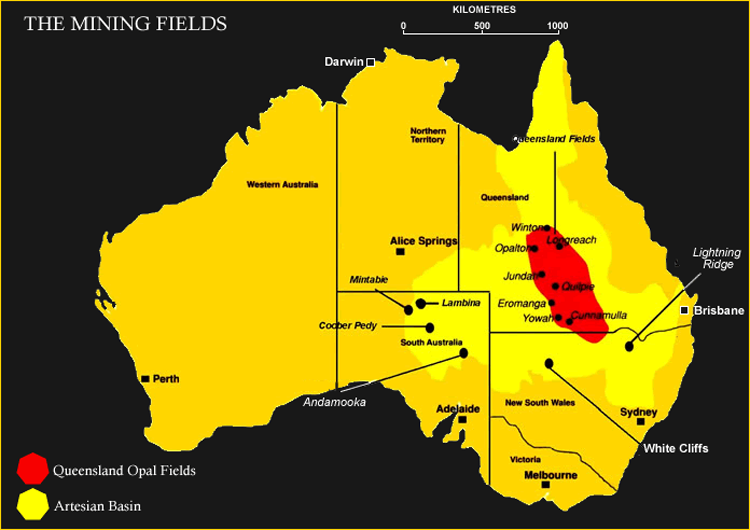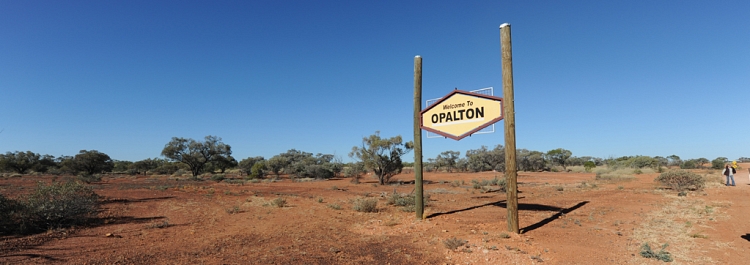In 1889 pioneer Tullie Wollaston set sail for England with a parcel of Queensland opal.
London gem merchants were unaccustomed to the brilliant Queensland gems and refused to purchase them. Wollaston persisted until the firm Hasluck Bros. of Hatton Garden agreed to trial the stones in Europe and America. Before long, Australian opal had been introduced to famous jewellery houses that began to feature opal in their designs, these included Tiffany, Lalique, and Carter. Wollaston established many markets for Australian opal. He died in 1931, a wealthy man. Australia now produces majority of the world’s opal supply. Australian opal is prized the world over, thanks to the pioneering efforts of Tullie Wollaston.
The major outcrops of opal in Australia occur along the shoreline of what was once The Great Inland Sea. The new Australian discoveries created great world interest in opal. Pioneers like Tullie Wollaston and E.F. Murphy helped develop these fields by marketing opal internationally and inspiring many to try their luck at mining. Miners worked and died in the harsh outback in the hope of making their fortune.
The important mining areas in Australian opal production over the last century have been White Cliffs, The Queensland Fields, Lightning Ridge, Grawin & Glengarry, Goober Pedy, Andamooka, Mintabie and Lambina.

White Cliffs
Commercial mining commenced in the late 1880s at the White Cliffs Field in New South Wales. The opal mined here excited the world and the town soon developed; by the 1920s it had a population of more than 3,000 people. White Cliffs produced fine quality seam material in such volumes as the world had not previously seen. Sadly, the main run was worked out by 1930 and the field all but died out.
Queensland fields
The Queensland fields are spread across 1,000 kilometres (600 miles) and produce almost all the world‘s supply of boulder opal.
This opal is produced from remote locations in the vicinity of Yowah, Eromanga, Quilpie, Jundah, Opalton and Winton. Almost all the opal is won by open cut mining. Large and small ironstone boulders are split in the search for that elusive opal vein.
Lightning Ridge
This field was discovered in 1905 by kangaroo shooters. “The Ridge” produces almost all of Australia’s sensational black opals and, despite a recent decline in production, it is still the largest producer of opal by value. (Lightning Ridge opal is typically found as nodules or “nobbies”.)
In the late 1980s the Coorcoran field 30 km to the west of the township produced stunning black nobby opal in great quantities.
The population soared to over 8,000 people. At this time opal sold for record prices sometimes at more per carat than good quality diamond. Outlying fields include The Grawin, Glengarry, Sheep Yards and Mulga Rush, which predominantly produce dark and black seam opal.
Andamooka
Andamooka is in the harsh desert and located near the edge of Lake Torrens (a saltpan over 165k or 100 miles in length). The field was discovered in 1935 and is famous for producing brilliant crystal seam opal.
Andamooka reached its peak in the 1960s when the population reached 3,000. Unfortunately this field is worked out, with very little commercial production since the 1970s. Today much of Andamooka’s population is employed at the nearby uranium mines of Roxby Downs.
Coober Pedy
The bulk of the world’s light seam opal has been mined at Coober Pedy. Mining extends over an area 50 kilometres long, running approximately north/south. The town reached its peak in the 1970s when enormous quantities of opal were being produced. It attracted many migrants from all over the world, seeking to make their fortune. Illegal gambling joints proliferated, some with dozens of tables where tens of thousands of dollars changed hands.
Unbearable summer temperatures have resulted in most of the population living underground in dugouts. By 2008 Coober Pedy’s production had fallen to 15% of its heyday but this dusty, hot outback town remains home to more than 4,000 people representing at least 50 nations.
Mintabie
The fortunes of Mintabie came and went within a decade. In 1978 a group from Coober Pedy found good quality black opal. Within a few years the population grew to 1,500. Large powerful equipment was needed to rip the hard sandstone. More than 75 large bulldozers, together with many scrapers and excavators, quickly mined out this very rich outcrop. Mintabie produced fine quality light and black seam opal. This material was extremely hard; in some cases it is able to scratch agate. Today there is only very limited mining activity.
Lambina
This field steadily grew from 1989, when production from neighbouring Mintabie was in sharp decline. In 2002 Lambina was the only shining light of the South Australian opal fields, with over 300 miners working with bulldozers and excavators. Sadly, by 2005, this field too was also in decline. The material is typically light and dark seam opal.





